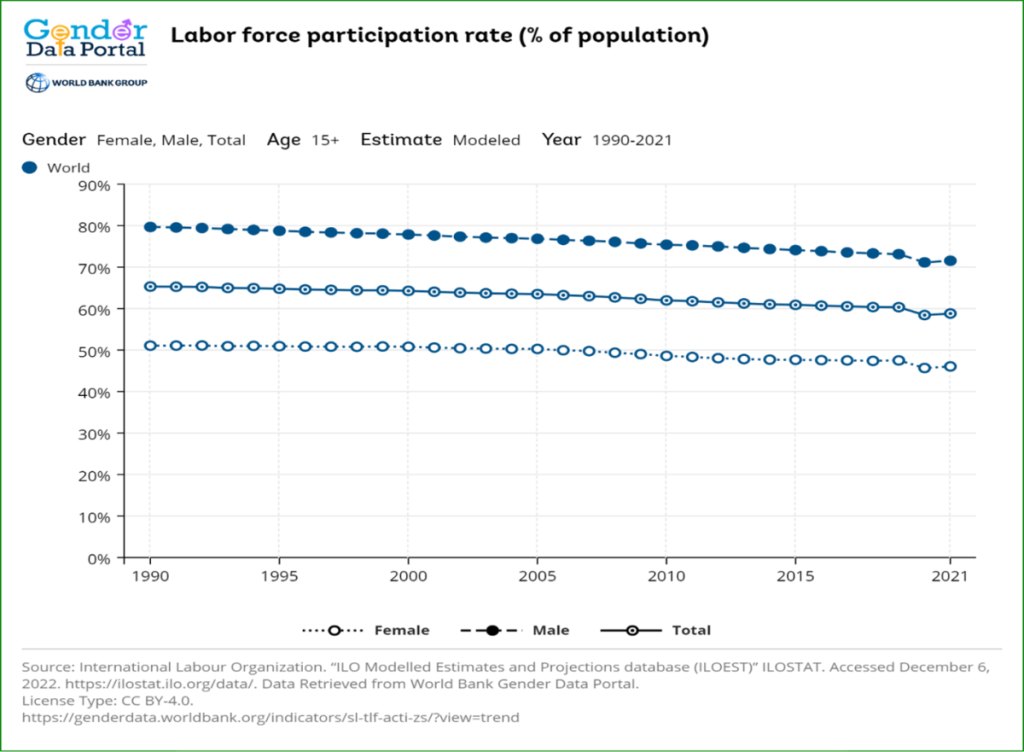
Female Labour Force Participation: Its Economic and Social Benefits
Labour force comprises people aged 15 and older who supply labour to produce goods and services during a specified period. Female labour force participation refers to the percentage of women active in the labour force.
Female labour force participation is considered a critical determinant for economic and social progress. From the economic perspective, a high female labour force participation is associated with higher economic growth and development (Pampel & Tanaka, 1986; Verick, 2018). With the participation of females in the labour force, the overall size of labour force increases, which leads to a positive multiplier effect, such as greater production, greater purchasing power of the population, greater income levels at the micro and macro level, etc. From the societal perspective, increasing female labour force participation can lead to greater gender equality and women’s empowerment (Winkler, 2022).
Theoretical Perspectives and Trends in Female Labour Force Participation
The issue of female labour force participation is complex and interdisciplinary in nature. It can be examined through the lens of several theories. According to the ‘Human Capital Theory’ put forward by Becker (1964) and Schultz (1961), as women have increased their levels of education and training, they have also increased their participation in the labour force. While Becker’s (1957) ‘Discrimination Theory’ suggests discrimination as the differential treatment of two individuals with identical observable productive characteristics, due to an observable non-productive characteristic. Similarly, ‘The Socialisation Theory of Gender’ can explain how traditional gender roles may discourage women from working outside the home.
Across the globe, women face inferior employment opportunities compared to men and are less likely to seek work for income. As per the latest estimates of the World Bank (2022), the global labour force participation rate for women is just about 46% compared to about 72% for men. As noted in Figure 1, in 1990, female labour force participation was 51.2%, as compared to 79.8% for men. This denotes a 28.6% gender gap in employment in 1990. In 2021, female labour force participation stands at 46.2% and 71.7% for males, denoting a 25.5% gender gap in employment. This highlights that the gender gap in employment is not decreasing. Even after 30 years of remarkable social and economic progress across the globe, females tend to be excluded from the mainstream when it comes to employment.
Figure 1: Trends of Labour Force Participation (1990-2021)

Source: Retrieved from The World Bank Database (https://genderdata.worldbank.org/indicators/sl-tlf-acti-zs/?view=trend) on 27/3/23
How can Foreign Direct Investment Impact Female Labour force Participation?
Among the many factors that have been impacting labour force participation of females, Foreign Direct Investment (FDI) is one. As defined by the OECD, “Foreign direct investment (FDI) is a category of cross-border investment in which an investor resident in one economy establishes a lasting interest in and a significant degree of influence over an enterprise resident in another economy.” Foreign Direct Investment (FDI) is referred to as one of the most striking features of the global economy in past decades (Mallampally & Sauvant, 1999). OECD (2002) describes FDI as a vital part of a vibrant open economic system, and a catalyst for economic development. FDI has been impacting countries, economies, employment, and livelihoods more than ever before. UNCTAD’s World Investment Report 2022 shows that global foreign direct investment (FDI) grew 64% in 2021, reaching nearly $1.6 trillion. With the ever-increasing growth and significance of FDI, investigating the relationship between FDI and female labor force participation become a pertinent issue for discussion in today’s time.
While studies deliberating upon the role of FDI on employment have established that FDI has a positive impact on job creation, employment generation and income levels (Malik, 2019; Rizvi & Nishat, 2009), the impact of FDI through the lens of gender and employment has been a raging debate.
Foreign Direct Investment (FDI) can have both positive and negative effects on female labor force participation. On the positive side, FDI can lead to job creation and economic growth, which can increase opportunities for women to participate in the labour force. FDI can also bring in new technologies and management practices that can improve the productivity and competitiveness of women-owned businesses. According to World Bank’s World Development Report (2012), more females could be preferred in the hiring process if the new technology brought in by FDI inflows is more complementary to the female workforce. If the source of FDI is a more developed and gender-equal country, FDI can create more gender-equal norms in the host country. Studies by Kucera (2001), Olcott & Oliver (2014); and Abe, Javorcik & Kodama (2016) have testified that majority-owned foreign firms are more likely to have female participation, specifically in higher positions, lower gender wage gap and female-friendly policies in the workplace. Such policies can spill over to the local establishments (Carr, 2016), eventually creating a positive work environment for women, and thus increasing their labor force participation.
While on the negative side, FDI can lead to increased competition for jobs, which can make it harder for women to find and retain employment. FDI can also have a negative impact on the labour force participation rate of women in certain circumstances and industries (Missios, 2018; Ouedraogo & Marlet, 2018). Additionally, FDI in certain male-dominant sectors, can lead to the displacement of women workers, and widen the wage gap. Rasekhi & Hosseinmardi (2012) warned that in certain instances, gender wage gap could also increase due to FDI, owing to weak bargaining power of female work force.
The Way Forward
It can be summarised from the discussion that FDI can have both positive and negative effects on female labor force participation. However, the impact is likely to depend on the nature and specific characteristics of the FDI project and the local economy. For instance, FDI in sectors such as manufacturing and construction may not provide as many opportunities for women, as these industries tend to be male dominated. On the other hand, FDI in sectors such as healthcare and education may provide more opportunities for women. Additionally, FDI in sectors such as textiles and garments, which are traditionally considered as “female-intensive” industries, may also provide more opportunities for women.
It is pertinent to note that factors such as employment policies and public policies of a country play a significant role in FDI induced impact on female labour force participation. The participation of women in the policy making process is bound to be a key factor for FDI to play a catalyst in promoting female labour force participation. Political representation of women must be necessitated at each level of governance. Countries such as India, wherein the participation of females in labour force is among the lowest in the world must take cognisance of the sectors wherein FDI is coming in, and FDI in sectors that embrace a gender diverse work environment should be encouraged. Channelising the substantial increase in foreign direct investments across the globe into inducing meaningful development outcomes, including increasing female labour force participation must be a potential goal for all nations. It would not only lead to immense economic benefits at the micro and macro level, but also create a much more inclusive society.
References
https://www.rieti.go.jp/jp/publications/dp/16e015.pdf
https://press.uchicago.edu/ucp/books/book/chicago/H/bo3684031.html
https://repository.library.georgetown.edu/handle/10822/1040803
https://press.uchicago.edu/ucp/books/book/chicago/E/bo22415931.html
https://www.ilo.org/wcmsp5/groups/public/—dgreports/—inst/documents/publication/wcms_250977.pdf
https://ssrn.com/abstract=313079
https://isid.org.in/wp-content/uploads/2019/04/WP206.pdf
https://www.oecd.org/investment/investmentfordevelopment/1959815.pdf
https://www.imf.org/external/pubs/ft/fandd/1999/03/mallampa.htm
https://scholar.umw.edu/student_research/258
https://journals.sagepub.com/doi/abs/10.1177/0950017013490333
https://www.jstor.org/stable/2578815
https://ijbds.usb.ac.ir/article_1272_0dcce3c3291568b130df8db2caacca46.pdf
https://www.ssc.wisc.edu/~walker/wp/wp-content/uploads/2012/04/schultz61.pdf
https://wol.iza.org/articles/female-labor-force-participation-and-development/long
https://wol.iza.org/uploads/articles/596/pdfs/womens-labor-force-participation.pdf
https://elibrary.worldbank.org/doi/abs/10.1596/978-0-8213-8810-5

Author Bio: Nikhat Khalid, is a Teaching Assistant & Analyst at the Bharti Institute of Public Policy, Indian School of Business. Her areas of research include international economics, macroeconomics and development economics. Her doctoral work at the Department of Economics, Jamia Millia Islamia was on the intersection of trade, technology and regional economic integration. A keen researcher, she has published research papers in several prestigious international and national journals and presented research work at numerous conferences.
DISCLAIMER : The views expressed in this blog/article are author’s personal.

